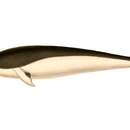Diagnostic Description
provided by FAO species catalogs
Southern right whale dolphins, along with their Northern Hemisphere counterparts, are the most slender of all cetaceans. The body shape is essentially the same as in the northern right whale dolphin, with a short, well-demarcated snout, small recurved flippers, extremely narrow (top to bottom) tail stock, small flukes with a concave trailing edge, and no hint of a dorsal fin or ridge. The white coloration of the ventral area extends well up the sides; the sharp line demarcating black above and white below runs from the tail stock forward, dips down to the flipper insertion, and then sweeps back up to cross the melon between the blowhole and snout crease. The flippers are generally white, but the trailing edge has a black band. The flukes are white below, and dark grey, fading to white on the leading edge, above. The mouth is lined with 44 to 49 sharp, pointed teeth in each row. Can be confused with: The unique body shape of this species should make it easy to distinguish from other species.
- bibliographic citation
- Marine mammals of the world. Jefferson, T.A., S. Leatherwood & M.A. Webber - 1993. FAO species identification guide. Rome, FAO. 320 p. 587 figs. .
- author
- Food and Agriculture Organization of the UN
Size
provided by FAO species catalogs
These dolphins reach lengths of at least 3 m and weights of 116 kg. Length at birth is probably about 1 m.
- bibliographic citation
- Marine mammals of the world. Jefferson, T.A., S. Leatherwood & M.A. Webber - 1993. FAO species identification guide. Rome, FAO. 320 p. 587 figs. .
- author
- Food and Agriculture Organization of the UN
Brief Summary
provided by FAO species catalogs
Large schools are characteristic of the southern right whale dolphin. Some estimates of group size range to over 1 000 animals. Associations with other marine mammal species are common, especially dusky dolphins and pilot whales. Like their northern cousins, dolphins of this species are active energetic swimmers, often coming out of the water in clean low-angle leaps as they move at speed. Fluke slaps and other aerial displays are common. Southern right whale dolphins occasionally bowride. Almost nothing is known of this species' reproductive biology. A variety of fish and squid have been reported as prey; lanternfish are especially common.
- bibliographic citation
- Marine mammals of the world. Jefferson, T.A., S. Leatherwood & M.A. Webber - 1993. FAO species identification guide. Rome, FAO. 320 p. 587 figs. .
- author
- Food and Agriculture Organization of the UN
Benefits
provided by FAO species catalogs
Although occasionally taken by whalers in the 1800s for food, southern right whale dolphins appear to be nowhere heavily hunted. They are known to be taken incidentally in driftnets along the coasts of Peru and Chile, and some are taken in the Peruvian small cetacean fishery. IUCN: Insufficiently known.
- bibliographic citation
- Marine mammals of the world. Jefferson, T.A., S. Leatherwood & M.A. Webber - 1993. FAO species identification guide. Rome, FAO. 320 p. 587 figs. .
- author
- Food and Agriculture Organization of the UN

